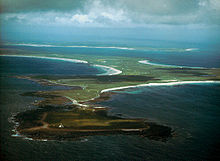Sanday, so called because of its sandy beaches, is thought to have been mostly underwater at some periods of prehistory. Archaeological evidence suggests that it at one time consisted of several smaller islands which joined together when the sea level decreased. There is a similarly named island, Sandoy, in the Faroe Islands. The island has large sand dunes where seals and otters can be found. Inland it is fertile and agricultural and there is some commercial lobster fishing. The underlying geology is predominantly Devonian sediments of the Rousay flagstone group with Eday sandstone in the south east.[7]
The novelist Eric Linklater described Sanday's shape seen from the air as being like that of a giant fossilised bat.[2]
There are several SSSIs on Sanday and the marine coast around the east of the island is designated a Special Protection Area due to presence of sand dune and machair habitats, rare outside the Hebrides, as well as extensive intertidal flats and saltmarsh.[8]
History
Attractions on the island include the Quoyness chambered cairn, dating from the 3rd millennium BC. A large man-made mound at Pool was excavated in the 1980s. This indicated a Neolithic structure made of turf or burnt peat, a later pre-Viking sub-circular structure with pavings and cells, and a Viking stone and turf rectangular building dated to the late 8th or early 9th century. Various implements were also discovered including pre-Norse hipped pins and pottery from both the pre-Viking and Norse periods. A predominance of fish and animal bones suggests the site was used for meat processing.[7] Storms in January 2005 exposed a Bronze Age burnt burial mound at Meur.[9] At the ruined Kirk of Lady, near Overbister, are the Devil's Fingermarks, a petrosomatoglyph, incised as parallel grooves into the parapet of the kirk. During World War II, the Royal Air Force built a Chain Home radar station at Whale Head on Sanday. Sanday also once boasted the most northerly passenger railway in the United Kingdom, Sanday Light Railway.
Lighthouse
Start Point lighthouse on Sanday was completed on 2 October 1806 by engineer Robert Stevenson. It was the first Scottish lighthouse to have a revolving light and since 1915 has exhibited distinctive black and white vertical stripes which are unique in Scotland. The light was automated in 1962 and is powered by a bank of 36 solar panels.[10]
Despite the presence of the lighthouse, HMS Goldfinch was wrecked in fog on Start Point in 1915.[11]


No comments:
Post a Comment